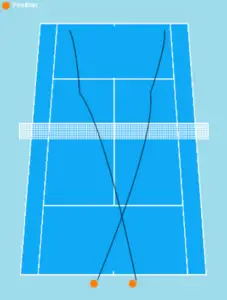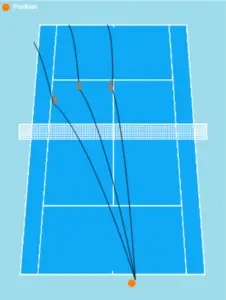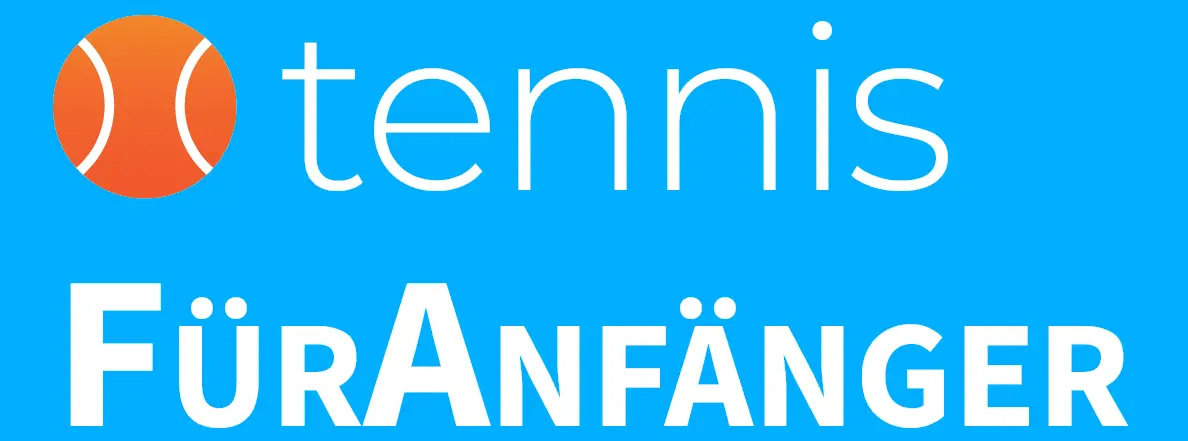Tennis service exercises
The best 7 tennis serve exercises for beginners
The best 7 tennis serve exercises for beginners
Building on the first tennis rallies from the baseline and first volleys at the net, it’s time to focus on the serve as a beginner. The serve opens the point and is therefore an important cornerstone for successful tennis players.
In the beginning, beginners should practice the correct serving technique over and over again to avoid as many double faults as possible – and thus points given away to the opponent.
After the completed warm-up program, we explain below to tennis beginners the best 7 serve exercises for beginners. Especially for the serve exercises it is recommended to work with a tennis coach, but also alone the serve can be trained and refined.
To increase self-confidence and also the success rate, it is recommended to do the serve exercises in the mentioned order at the beginning. The more confident you feel, the faster you can start with exercise 3 in the next training session.
If, on the other hand, you feel a little insecure, you should go back one exercise. And as always: practice makes perfect – have fun with your serve tennis training.
1. Serve throwing
To practice the stroke arm movement, stand behind the baseline on the left or right side of the center line. You don’t need a tennis racket for this exercise, just a tennis ball in your strong hand.
Then throw the tennis ball from the slightly sideways serving position, bending the throwing arm into the imaginary backpack and fully extending it upwards. The ball should be thrown diagonally in an arc into the T-field and the backswing completed without a tennis racket.
The goal of the exercise is to gain a feel for the distance and thus the necessary power. Of course, with the tennis racket in your hand you have a much greater leverage, but you should still be able to throw the tennis ball skillfully into the correct T-field.
2. Ball toss exercise
A good ball toss is almost half the battle when serving, so take a tennis ball on the ball tossing side and again stand slightly to the right or left of the center line behind the baseline.
As a right-handed player, the ball toss should come up with your left hand slightly to the right in front of your body, i.e., in the court. Practice throwing the ball straight up, including bouncing, so that you develop a feeling for a good or not so good ball throw.
If you are left-handed, throw the ball with your right hand. The goal is for the ball to bounce to the left in front of your body.
3. Serve with 2 tennis balls
Again, stand behind the baseline on the right or left side of the center line with a tennis ball in each hand.
The aim of the exercise is to simulate the serving motion. To do this, you will make the complete backswing motion. Instead of hitting the tennis ball from the ball throw with the tennis racket, you throw the tennis ball from your hitting hand to the tennis ball in the air.
The goal is for both tennis balls to touch. Be sure to make a judicious ball toss and proper batting arm motion out the top.
4. Serve with tennis racket
Now it’s time to pick up the tennis racket. Stand in the serving position and try to hit the tennis ball into the correct T-field using the correct serving technique.
Make sure you throw the ball correctly and break the serve instead of wandering across the court because of a bad throw or bending at the point where the ball hits the court.
Practice the serve several times from both sides of the center line and get routine in the serve: from the backswing to the movement to the outswing.

5. Focus on 2nd serve
After you have internalized the serve technique, you will turn your attention to the 2nd serve. The 2nd serve is a frequent source of errors, especially for beginners.
Therefore, practice only the 2nd serve with one tennis ball at a time, but the correct technique. The goal is to serve at least 9 out of 10 serves on each side of the center line into the correct T-field.
If you can do that, there’s not much standing in the way of your first points with a serve.
6. Serve placement
After you feel more and more confident on the serve with the right technique, it’s time to place the serve. Not many opponents have the same forehand and backhand strength, so it’s worth practicing placing the serve – even on the opponent’s body.
For example, place an empty ball can or a small hat from the tennis coach on the spot in the T-field where you want to serve. Try all 3 variations: on the forehand side of the opponent, on the body of the opponent and on the backhand side of the opponent.
The aim of the exercise is to make your serve more variable and unpredictable for your opponent. This applies to both the left and right side of the center line on serve.

7. Match simulation with serve
After the possibility to place your own serve, the match can be simulated. For this you take two tennis balls: one for the pocket for a potential 2nd serve and the other tennis ball for the 1st serve.
You start from the right side of the center line and if the 1st serve goes into the right T-field, you get another 2nd tennis ball and switch to the left side of the center line. Otherwise you perform a 2nd serve.
The 1st serve is played with more risk, but you should still have a hit rate of >50%. If this is not the case, it is better to go back one or the other exercise.
The goal is to be ideally prepared for a real match, i.e. to get into the rally well with good first serves and possibly even win easy points, but it is even more important for tennis beginners not to make unnecessary double faults.

